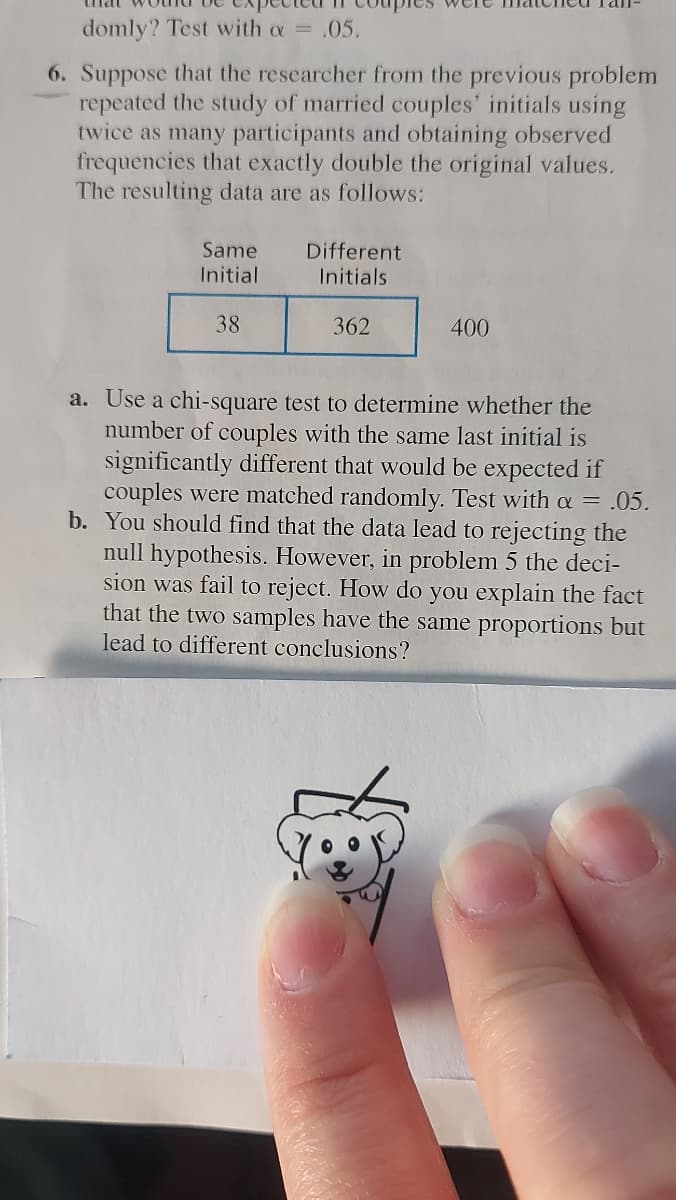6. Suppose that the researcher from the previous problem repeated the study of married couples' initials using twice as many participants and obtaining observed frequencies that exactly double the original values. The resulting data are as follows: Same Different Initial Initials 38 362 400 a. Use a chi-square test to determine whether the number of couples with the same last initial is significantly different that would be expected if couples were matched randomly. Test with a = .05. b. You should find that the data lead to rejecting the null hypothesis. However, in problem 5 the deci- sion was fail to reject. How do you explain the fact that the two samples have the same proportions but lead to different conclusions?
6. Suppose that the researcher from the previous problem repeated the study of married couples' initials using twice as many participants and obtaining observed frequencies that exactly double the original values. The resulting data are as follows: Same Different Initial Initials 38 362 400 a. Use a chi-square test to determine whether the number of couples with the same last initial is significantly different that would be expected if couples were matched randomly. Test with a = .05. b. You should find that the data lead to rejecting the null hypothesis. However, in problem 5 the deci- sion was fail to reject. How do you explain the fact that the two samples have the same proportions but lead to different conclusions?
Algebra & Trigonometry with Analytic Geometry
13th Edition
ISBN:9781133382119
Author:Swokowski
Publisher:Swokowski
Chapter5: Inverse, Exponential, And Logarithmic Functions
Section5.6: Exponential And Logarithmic Equations
Problem 69E
Related questions
Question

Transcribed Image Text:domly? Test with a = .05.
6. Suppose that the researcher from the previous problem
repeated the study of married couples' initials using
twice as many participants and obtaining observed
frequencies that exactly double the original values.
The resulting data are as follows:
Same
Different
Initial
Initials
38
362
400
a. Use a chi-square test to determine whether the
number of couples with the same last initial is
significantly different that would be expected if
couples were matched randomly. Test with a = .05.
b. You should find that the data lead to rejecting the
null hypothesis. However, in problem 5 the deci-
sion was fail to reject. How do you explain the fact
that the two samples have the same proportions but
lead to different conclusions?
Expert Solution
This question has been solved!
Explore an expertly crafted, step-by-step solution for a thorough understanding of key concepts.
This is a popular solution!
Trending now
This is a popular solution!
Step by step
Solved in 2 steps with 2 images

Recommended textbooks for you

Algebra & Trigonometry with Analytic Geometry
Algebra
ISBN:
9781133382119
Author:
Swokowski
Publisher:
Cengage

Algebra & Trigonometry with Analytic Geometry
Algebra
ISBN:
9781133382119
Author:
Swokowski
Publisher:
Cengage